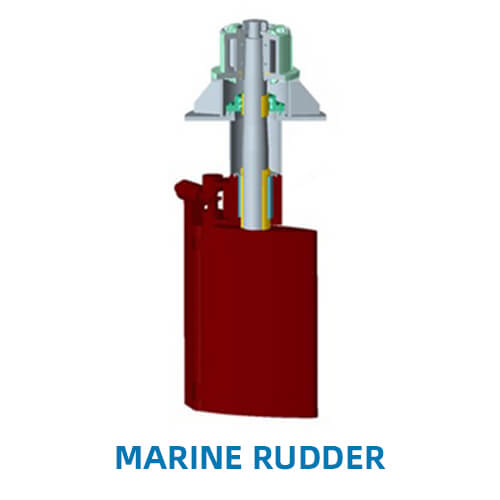Key Features of a Marine Rudder:
- Design and Construction:
- Blade: The rudder blade is the main surface that interacts with the water flow. It can be made from materials such as steel, aluminum, or composite materials. The shape and size of the blade affect the rudder’s performance and maneuverability.
- Stock: The stock is the vertical shaft that connects the rudder blade to the steering mechanism. It transmits the forces from the steering system to the rudder blade.
- Hanger and Pintles: These are the components that support and pivot the rudder. The hanger is attached to the rudder stock and allows the rudder to rotate, while the pintles are fixed to the vessel’s hull and provide a pivot point.
- Types of Marine Rudders:
- Conventional Rudders: These rudders are mounted on the stern of the vessel and operate by creating a pressure difference between the two sides of the blade. They are simple and widely used in various types of vessels.
- Balanced Rudders: These have a portion of the rudder blade forward of the pivot point, which helps to reduce the steering forces required and improve maneuverability.
- Semi-Balanced Rudders: Similar to balanced rudders but with a smaller portion of the blade forward of the pivot point, offering a compromise between conventional and fully balanced designs.
- Skeg Rudders: These are mounted on a skeg or support structure that extends from the hull, providing additional support and protection to the rudder. They are commonly used on larger vessels and offer improved stability.
- High-Lift Rudders: Designed with an airfoil shape to provide greater lift and maneuverability, especially at lower speeds.
- Applications:
- Commercial Vessels: Used in cargo ships, tankers, and ferries to provide precise steering and control during navigation and docking.
- Recreational Boats: Found in pleasure boats, yachts, and fishing vessels, where maneuverability and handling are essential for safe and enjoyable operation.
- Naval Vessels: Utilized in military and patrol boats, where advanced rudder designs contribute to tactical maneuverability and performance.
- Performance Characteristics:
- Steering Control: The effectiveness of the rudder in steering the vessel depends on its design, size, and the flow of water around the blade.
- Maneuverability: The rudder’s ability to turn the vessel is influenced by its shape and positioning. Balanced and high-lift rudders offer improved maneuverability.
- Hydrodynamic Efficiency: A well-designed rudder minimizes drag and turbulence, improving the vessel’s overall efficiency and performance.
- Maintenance and Care:
- Regular Inspection: Inspect the rudder for signs of wear, damage, or corrosion. Check the blade, stock, and supporting components for proper function.
- Cleaning: Keep the rudder clean from marine growth, debris, and salt deposits. Regular cleaning helps maintain performance and prevent corrosion.
- Lubrication: Ensure that moving parts, such as bearings and hinges, are properly lubricated to ensure smooth operation and prevent wear.
- Safety Considerations:
- Proper Operation: Ensure that the rudder is operated according to manufacturer guidelines to avoid excessive wear or damage.
- Emergency Procedures: Be familiar with emergency procedures in case of rudder failure or malfunction, including alternative steering methods or backup systems.
- Training: Crew members should be trained in the operation and maintenance of the rudder system to ensure safe and effective use.
Advantages of Marine Rudders:
- Precision Steering: Provides accurate control over the vessel’s direction, enhancing navigation and maneuverability.
- Versatility: Suitable for a wide range of vessel types and sizes, from small recreational boats to large commercial ships.
- Improved Handling: Contributes to the vessel’s overall handling and performance, especially in challenging conditions or tight spaces.
Considerations for Marine Rudders:
- Design Choice: The choice of rudder design affects the vessel’s performance, maneuverability, and efficiency. Considerations include the type of vessel, operational requirements, and environmental conditions.
- Cost and Maintenance: High-quality rudders can be costly, and regular maintenance is essential to ensure optimal performance and longevity.
Marine rudders are vital components for steering and controlling vessels, offering precision and maneuverability in various marine environments. Their design, maintenance, and operation play crucial roles in ensuring safe and efficient navigation.






